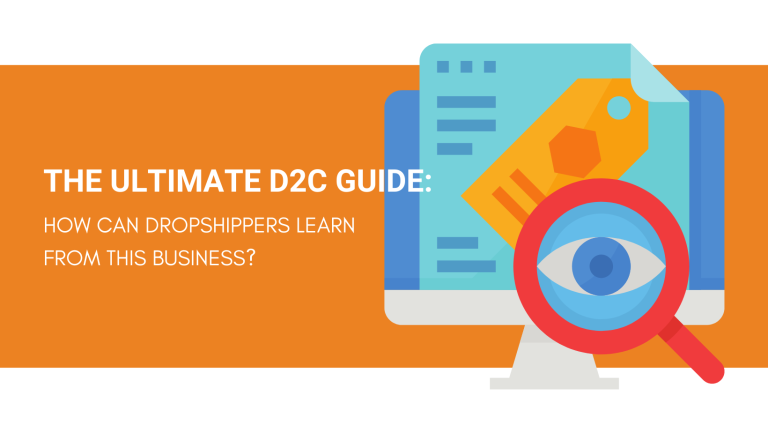Almost 90% of dropshipping stores fail within their first year of operations. That’s because most people have started seeing it as an easy money-making scheme.
They copy-paste every aspect from the internet and bring little to no innovation to the table. This approach may occasionally work for a few months, but sooner or later, you’re bound to run out of luck.
If you’re seeking long-term results, then it’s pivotal to build a unique selling point for your business. And that usually isn’t possible without transitioning into a brand.
This is why you may want to take a page from D2C companies by learning how they work and the reason behind their success. Fortunately, that is exactly what we’ll be discussing in this guide.
We’re going to walk you through everything you need to know about the Direct to Consumer (D2C) business model so you can scale up into a brand and outlive your competition.
Let’s dive straight into it!
What Is Direct to Consumer?
A Direct to Consumer is a business model in which the products are directly sold to the end customers. There are no middlemen or distribution networks involved to generate sales. It is also commonly referred to as D2C or DTC.

Why Are D2C Brands Successful?
Over the years, D2C brands have seen a massive surge in terms of popularity and success, with sales expected to reach $175 billion by 2025.
The credit for that goes to the control that this business model offers. You can sell the products to the customers at a low price, and still, keep more margin than what you get from the retailers.
At the same time, since you’re directly interacting with the customers you get all their data. You can stay updated with their growing demands and incorporate their feedback to improve your product from all fronts.
But of course, not all D2C brands are successful. There’s a lot to consider before you launch a D2C company that we’ll discuss in a later part of this guide.

What are the Benefits of a D2C Brand?
A large number of entrepreneurs have been shifting their focus towards building a D2C brand. And given its benefits, the growing interest doesn’t come as a surprise.
So here are some of the advantages of starting a D2C brand:
Access to Customer Data
As we mentioned earlier, in a D2C business, there are no middlemen or distribution networks involved.
You’re directly selling your product to the end customer, which also means that you get to collect all their data.
And it wouldn’t be an overstatement to say that data is one of the most economically valuable assets a business can have in today’s world.

Control Over the Prices
Traditional stores sell their products at a cheap price to retailers who then further distribute them to the consumers. However, that isn’t the case for a D2C business.
A D2C brand has more control over the prices since there’s no involvement of retailers and middlemen.
You can sell your products to the customer at lower than market prices and still keep a great profit margin.

Better Customer Relationship
Most D2C brands have a loyal customer base. The credit for that goes to the control you have over your business. Retailers often think about making money and the complaints of the customers aren’t taken into account, or they simply don’t reach the brand.
However, it’s only natural to build a better customer relationship when you can engage more with your audience and can quickly incorporate their feedback.
In addition, if you’re offering the best price to your customers in comparison to similar products in the market, which is bound to get you more attention.
Opportunities for Innovation
Traditional brands are often afraid of trying new things. They get too comfortable with selling the most “in-demand” product to the retailer and making small bucks.
One thing you’ll notice in all successful businesses is that they aren’t afraid to innovate. They continuously bring fresh ideas to the table, even if things don’t work out, they learn from them.
Fortunately, a D2C brand opens a path to innovation for you. Since you’re directly dealing with the customers, you can try launching a new product on a smaller-scale and by using minimum resources.
If it gets a positive reception, then you can continue, but if not, then there’s always the option for pulling back.

What Are the Drawbacks of a D2C Brand?
Despite the growing popularity of D2C brands, this business model comes with its fair share of risks. So here are some of the most common drawbacks of a D2C brand.
Potential Security Threats
According to Cybersecurity Ventures, $10.5 trillion individuals will be lost annually by 2025. This speaks volumes of how common cyber-attacks and data theft have become.
This is why as a D2C business owner, it’s your responsibility to protect the confidentiality of your customers.
Understanding the complexities behind online security can be quite a challenge for non-tech-savvy people. As a result, your lack of knowledge can directly put your business at risk.

Shipping Logistics
Managing the shipping logistics is one of the biggest obstacles while launching a D2C brand. Late or defective deliveries are one thing that product-based businesses must always avoid.
The last thing you want is negative customer feedback, especially in the early days of your brand.
So this is a whole department that you need to take care of. If you don’t have enough connections, then order fulfillment alone would become a huge burden on you.
Dependency on Marketing
Every business nowadays requires a solid marketing strategy to succeed. However, in the case of D2C brands, the stakes are even higher. You don’t have middlemen or retailers to help you make some profit and you’re pretty much on your own.
If you’re not able to create a noticeable presence of your brand or do not devise a competent marketing strategy, then you’ll have a hard time surviving.
Various Expertise
Running a D2C brand basically requires you to become a jack of all trades. In addition to things like product hunting, you also have to solve supply chain issues, make time order fulfilments and much more.
All of this can be overwhelming for those who lack experience. This is the reason that despite the growing interest, entrepreneurs often feel reluctant to pull the trigger for building a D2C brand.
5 Hallmarks of Launching a D2C Company
If you’re planning to build a D2C company, or even turning your dropshipping business into a brand, then here are 5 things that you should go through:
Focus on Customer Pain Points
If you look at other successful D2C brands like Casper and Dollar Shave Club, you’ll notice one common theme.
They know how to target the pain points of their customers.
All of them identified a problem and then presented a solution to catch the attention of their prospects.
For instance, before Casper came along, as disappointing as it sounds, buying mattresses wasn’t that easy. You’d have to pay sky-rocketing prices for mediocre quality.
Casper made the process much easier and not only was their mattresses lower in cost and higher in quality but also, convenient to purchase.
The mattress would be conveniently delivered to your doorstep in an easy to manage box.
As simple as it sounds, this is the problem they targeted, and considering the majority of the population needs a mattress to sleep on, their business boomed.
Survey the Market for Similar Solutions
Bringing a “new” product into the market has become next to impossible now. A better approach is to find an advanced variation of an already existing product.
This is where a market survey comes in. Regardless of how saturated the market is, with the right planning and approach, there’s always a chance to break through.
The Dollar Shave Club is a great example of that. They’re a famous razor D2C brand but before their success, 70% of the razor market was held by Gillette.
So how did The Dollar Shave Club breakthrough? Well, they made buying razors easier than Gillette through their subscription-based model.
For most men, shaving is a part of everyday life, so their subscription model automatically gets the razors delivered to their doorstep.
In addition, their razors aren’t anything fancy either, but they’re of high quality and do perfectly what they’re meant to do.
So the takeaway from this story is to survey the market. Even if competitors are selling similar products, try finding where they’re lacking. And what the customer is looking for, then add all of that up in the form of your brand.

Evaluate your Resources
Launching a D2C or even a private label dropshipping brand is a huge step. Before you get right into it, you must evaluate your resources.
In the case of D2C businesses, a lot more responsibility falls on your shoulders in comparison to traditional eCommerce stores.
For starters, you need to find a product that you can upscale. And then, there’s packaging, developing a brand identity, and whatnot.
But these aren’t even the hardest parts, because supply chain issues and shipping is another aspect that you’ll need to learn more about.
Building a D2C brand is a huge investment. And if you jump into it without preparation then you’re going to have a hard time surviving.
This is also one of the reasons that you see more traditional eCommerce stores than D2C brands.
It’s a huge commitment and even before you build a brand, you need to build its foundation.
Form a Product Strategy
A sound product strategy is not only important for D2C companies, but also for dropshippers or any other eCommerce business.
The first step is to make sure that your product goes through a trial and testing phase. This test can either be conducted by your QA team or by a customer.
Similarly, the testing phase isn’t just limited to giving the product away to the customers. It could include strategies such as free delivery, bulk discounts and offers like buy one get one free.
The goal of this phase is to determine what works for your business and helps you attract more audiences.
And then there are also the product prices that you have to look into. Although D2C brands do offer more flexibility on prices, you still need to look for the perfect balance at the beginning.
Set the prices at a level that aligns with the views and mission of your brand.
And if you’re having a hard time selling the old stock, then you can always offer discounted rates in the form of clearance sales.
Develop a Powerful Marketing Funnel
The general rule for running eCommerce stores is to develop a solid marketing strategy and that’s even more important for D2C brands.
There are numerous ways to market a brand nowadays which include running ad campaigns, getting the help of influencers, maintaining a blog and whatnot.
And if you can come up with creative viral videos then there’s nothing better than that.
All in all, there are multiple ways to market a D2C brand, if you want to learn more about the D2C marketing strategy, then we’ve covered that in detail.
Golden Takeaways for Dropshippers from D2C Brands
D2C and dropshipping are two entirely different business models. However, after going through how the D2C model works, its pros and cons, here are some takeaways that all dropshippers should learn from:

Focus on Building a Brand
The key to success for any business is to build a unique brand identity. Dropshipping follows the same principles.
If you compare the D2C approach with dropshipping, then you’d notice that all D2C businesses put all their efforts into making their brand recognizable.
Sure, a general dropshipping store may help you earn some short-term money.
But if you want the long-term dough then you need to scale up and focus on becoming a private-label brand.
Control the Quality of Suppliers
D2C brands have great control over the quality of products that they deliver to their customers.
We know there are some limitations to QA in dropshipping, but there are still many ways to work around and ensure that your customers get what they’re paying for.
If you can’t control the quality of products, then you can at least control the quality of suppliers. Rather than focusing on finding the cheapest supplier, aim to find the most reliable one.
Check reviews, place test orders or if you’re short on leads, then leave product sourcing in the hands of experts.
Build a Solid Marketing Strategy
Successful D2C brands go all-in to develop a powerful marketing funnel.
So once you launch a PL dropshipping business, depending on your budget, don’t just limit yourself to Facebook ads.
Try out other approaches like influencer marketing, video ads, or even consider starting a blog.
Offer Top-Notch Customer Service
Just because your orders are being fulfilled by a third-party supplier, doesn’t mean customer satisfaction isn’t your responsibility.
D2C brands go the extra mile to win customer loyalty. They’re quick to resolve any complaints and also offer hassle-free return and refund policies.
So if you’re launching a private or white label dropshipping brand, then make it look like one. Be quick with customer dealing and support, and always aim to provide satisfactory resolutions.
Final Thoughts
While there’s a huge difference between the D2C and dropshipping strategy, the general principle for success remains the same, and that is to build a brand.
Given how the Direct to Consumer approach is all the rage nowadays, having a keen understanding of it can significantly help dropshippers in launching a brand of their own.
This is why if you’re ready, then NicheDropshipping can help you take the leap by private labeling your products.
And if product quality is your concern, then we can also source your desired products at the most reasonable prices.
So contact us today to learn more about how our services can help you build your own brand.

